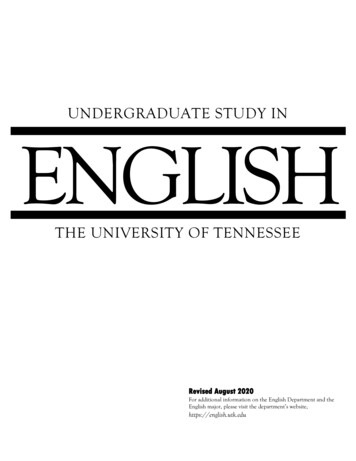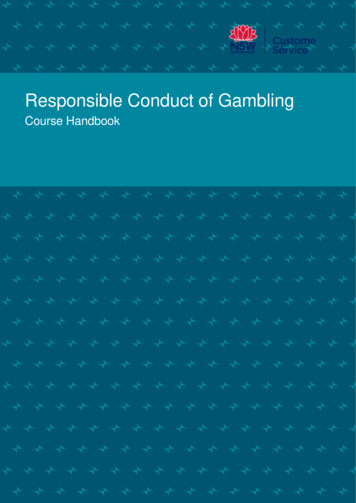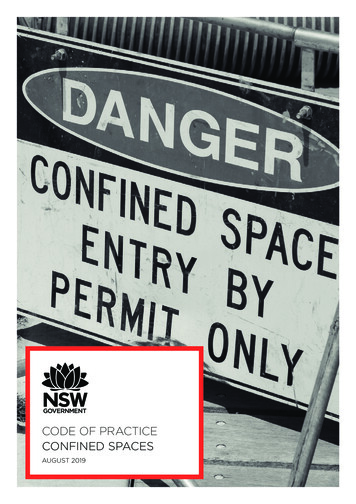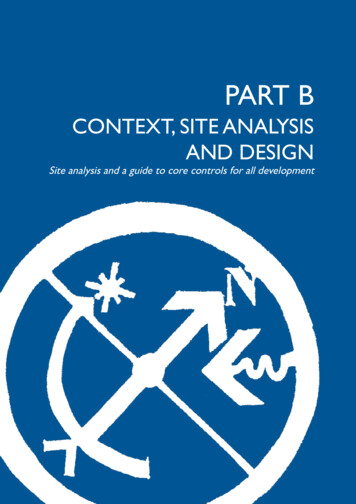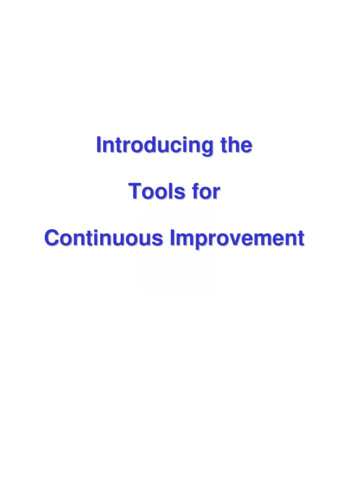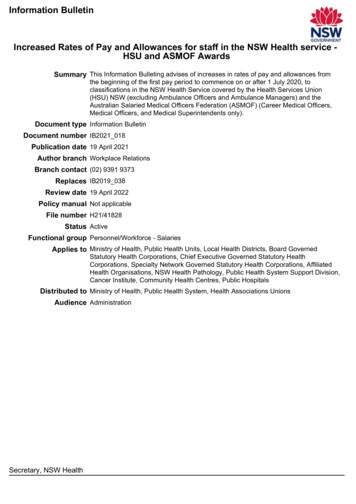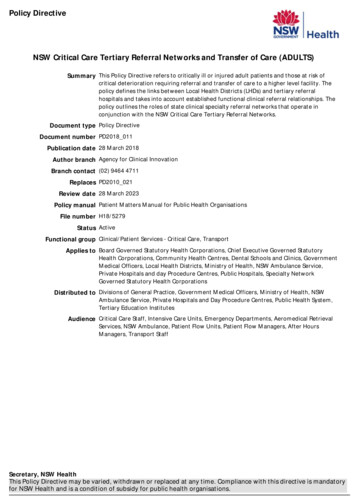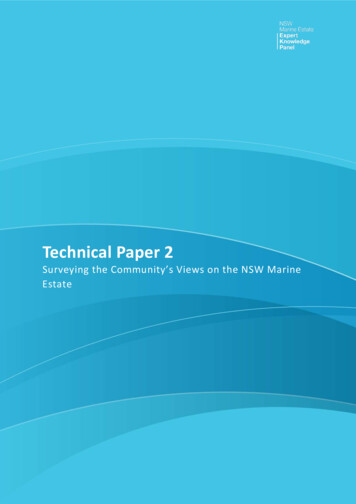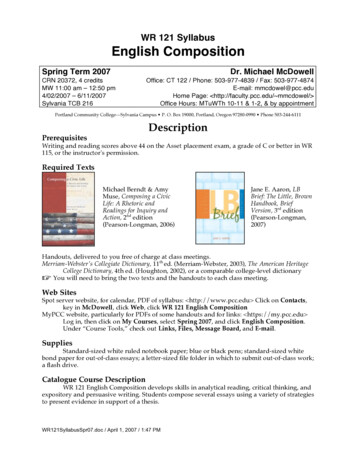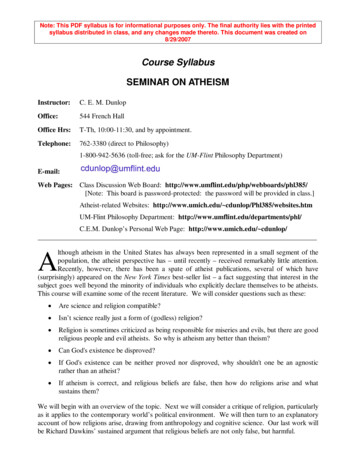
Transcription
EnglishStage 6Annotations of selected texts prescribed for theHigher School Certificate2019–23
2017 NSW Education Standards Authority (NESA) for and on behalf of the Crown in right ofthe State of New South Wales.The NESA website holds the ONLY official and up-to-date versions of these documentsavailable on the internet. ANY other copies of these documents, or parts of these documents,that may be found elsewhere on the internet might not be current and are NOT authorised.You CANNOT rely on copies from any other source.The documents on the NESA website contain material prepared by NESA for and on behalf ofthe Crown in right of the State of New South Wales. The material is protected by Crowncopyright.All rights reserved. No part of the material may be reproduced in Australia or in any othercountry by any process, electronic or otherwise, in any material form, or transmitted to anyother person or stored electronically in any form without the prior written permission of NESA,except as permitted by the Copyright Act 1968.When you access the material you agree: to use the material for information purposes only to reproduce a single copy for personal bona fide study use only and not to reproduceany major extract or the entire material without the prior permission of NESA to acknowledge that the material is provided by NESA to include this copyright notice in any copy made not to modify the material or any part of the material without the express prior writtenpermission of NESA.The material may contain third-party copyright materials such as photos, diagrams,quotations, cartoons and artworks. These materials are protected by Australian andinternational copyright laws and may not be reproduced or transmitted in any format withoutthe copyright owner’s specific permission. Unauthorised reproduction, transmission orcommercial use of such copyright materials may result in prosecution.NESA has made all reasonable attempts to locate owners of third-party copyright material andinvites anyone from whom permission has not been sought to contact the Copyright Officer.Phone: (02) 9367 8289Fax: (02) 9279 1482Email: copyright@nesa.nsw.edu.auPublished by NSW Education Standards AuthorityGPO Box 5300Sydney NSW 7/342752
ContentsIntroduction. 5COMMON MODULE . 7All the Light We Cannot See . 9Past the Shallows . 11I Am Malala . 13The Boy Behind the Curtain . 15Waste Land . 17ENGLISH STANDARD . 19Contemporary Asian Australian Poets . 21Ali Cobby Eckermann poetry . 23Reindeer in My Saami Heart . 25ENGLISH ADVANCED . 27The Stranger . 29The Meursault Investigation . 31Hag-Seed . 33David Malouf poetry . 35ENGLISH EAL/D . 37Past the Shallows . 39I Am Malala . 41Toyo . 43Contemporary Asian Australian Poets . 45Langston Hughes poetry . 47Reindeer in My Saami Heart . 49Emma Jones poetry . 51Waste Land . 53ENGLISH EXTENSION 1 . 55A Passage to India . 57Eileen Chong poetry . 59The Secret River . 61Brick Lane . 63Do Not Say We Have Nothing . 65Tracy K. Smith poetry . 67Pan’s Labyrinth . 693
As I Lay Dying . 71Katherine Mansfield short stories . 73Island Home . 75The Hunter . 774
IntroductionAnnotations have been developed for texts that are prescribed for the first time in 2019–23.These annotations provide information on new texts, in terms of how they address thefollowing text selection criteria: merit and cultural significancemeeting the needs and interests of studentsproviding opportunities for challenging teaching and learning.The annotations can assist in the choice of texts for particular candidatures and also providesome suggestions for approaching teaching and learning. They are not prescriptive and do notoffer guidelines for the interpretation of texts, modules or electives.5
6
Annotations of selected textsprescribed for theHigher School Certificate2019–23ENGLISH STANDARDENGLISH ADVANCEDENGLISH STUDIESCOMMON MODULE7
8
All the Light We Cannot SeeTYPE OF TEXT:AUTHOR:COURSES:MODULE:Prose FictionAnthony DoerrStandard, Advanced and English StudiesCommon ModuleDESCRIPTIONTexts and Human ExperiencesIn this common module students deepen their understanding of how texts represent individualand collective human experiences. They examine how texts represent human qualities andemotions associated with, or arising from, these experiences. Students appreciate, explore,interpret, analyse and evaluate the ways language is used to shape these representations in arange of texts in a variety of forms, modes and media.Students explore how texts may give insight into the anomalies, paradoxes andinconsistencies in human behaviour and motivations, inviting the responder to see the worlddifferently, to challenge assumptions, ignite new ideas or reflect personally. They may alsoconsider the role of storytelling throughout time to express and reflect particular lives andcultures. By responding to a range of texts they further develop skills and confidence usingvarious literary devices, language concepts, modes and media to formulate a consideredresponse to texts.Students study one prescribed text and a range of short texts that provide rich opportunities tofurther explore representations of human experiences illuminated in texts. They makeincreasingly informed judgements about how aspects of these texts, for example context,purpose, structure, stylistic and grammatical features, and form shape meaning. In addition,students select one related text and draw from personal experience to make connectionsbetween themselves, the world of the text and their wider world.By responding and composing throughout the module students further develop a repertoire ofskills in comprehending, interpreting and analysing complex texts. They examine how differentmodes and media use visual, verbal and/or digital language elements. They communicateideas using figurative language to express universal themes and evaluative language to makeinformed judgements about texts. Students further develop skills in using metalanguage,correct grammar and syntax to analyse language and express a personal perspective about atext.MERIT AND CULTURAL SIGNIFICANCE Written by the multi-award winning American author, Anthony Doerr, All the Light WeCannot See is a deeply moving novel about two young people whose lives intersect inoccupied France during World War II. It was a New York Times bestseller, and won the Goodreads Choice Award as BestHistorical Fiction of 2014. In 2015, it was awarded the Andrew Carnegie Medal for Excellence in Fiction and thePulitzer Prize for Fiction.NEEDS AND INTERESTS OF STUDENTS Examination of the ethical dilemmas faced by several characters will provoke discussionand debate about the influence of society on individual behaviour. In particular, studentswill find it interesting to consider the capacity for individual and collective resistance in theface of violence and oppression, and whether or not individuals can be so easilycharacterised as ‘good’ or ‘evil’.9
While it spans eight decades and several countries, the majority of the novel takes placein France and Germany during World War II. Students will be engaged by the historicalsetting of the novel and by the way that it provides insights into the experiences of twoteenagers during wartime.The potential for humans to maintain hope and integrity in the face of dire circumstances,reinforced through the motif of light in the novel, is uplifting.OPPORTUNITIES FOR CHALLENGING TEACHING AND LEARNING Students will consider how the structure of the novel, including its division into 14 parts, itsmovement back and forth in time and its use of foreshadowing, shapes their responses tothe characters and the narrative.Through their responding and composing students will develop a considered personalresponse to the novel and to the ideas that it explores, including how science, faith, luckand history provide interpretive frameworks through which humans make sense of theirexperiences. In doing so, they will examine the ways that the author uses symbolism,intertextuality and different perspectives to convey the novel’s ideas.The experiences of all of the characters, particularly those of Marie-Laure, the blindFrench girl who is at the centre of the novel, are richly represented through Doerr’s use ofevocative imagery. Study of the novel provides opportunities for students to analyse howword choice and description build verisimilitude in the creation of characters and theirworlds.10
Past the ShallowsTYPE OF TEXT:AUTHOR:COURSES:MODULE:Prose FictionFavel ParrettStandard, Advanced and English StudiesCommon ModuleDESCRIPTIONTexts and Human ExperiencesIn this common module students deepen their understanding of how texts represent individualand collective human experiences. They examine how texts represent human qualities andemotions associated with, or arising from, these experiences. Students appreciate, explore,interpret, analyse and evaluate the ways language is used to shape these representations in arange of texts in a variety of forms, modes and media.Students explore how texts may give insight into the anomalies, paradoxes andinconsistencies in human behaviour and motivations, inviting the responder to see the worlddifferently, to challenge assumptions, ignite new ideas or reflect personally. They may alsoconsider the role of storytelling throughout time to express and reflect particular lives andcultures. By responding to a range of texts they further develop skills and confidence usingvarious literary devices, language concepts, modes and media to formulate a consideredresponse to texts.Students study one prescribed text and a range of short texts that provide rich opportunities tofurther explore representations of human experiences illuminated in texts. They makeincreasingly informed judgements about how aspects of these texts, for example context,purpose, structure, stylistic and grammatical features, and form shape meaning. In addition,students select one related text and draw from personal experience to make connectionsbetween themselves, the world of the text and their wider world.By responding and composing throughout the module students further develop a repertoire ofskills in comprehending, interpreting and analysing complex texts. They examine how differentmodes and media use visual, verbal and/or digital language elements. They communicateideas using figurative language to express universal themes and evaluative language to makeinformed judgements about texts. Students further develop skills in using metalanguage,correct grammar and syntax to analyse language and express a personal perspective about atext.MERIT AND CULTURAL SIGNIFICANCE This debut novel by young Australian author, Favel Parrett, won her the Dobbie LiteraryAward and the Newcomer of the Year (Australian Book Industry Awards) in 2012. Past the Shallows was also shortlisted for a number of other literary prizes, including the2012 Miles Franklin Award, and has been likened to the writing of Tim Winton andCormac McCarthy. Set in the wild coastal terrain of south-eastern Tasmania in the 1980s, it is a raw andcompelling story of the bond between young brothers as they deal with harsh treatmentand personal challenges in the aftermath of their mother’s death.NEEDS AND INTERESTS OF STUDENTS Past the Shallows is a powerful and poignant story of the vulnerability of youth and thesometimes traumatic experience of coming of age. Students will be engaged by the11
depiction of the struggles relating to coming of age, and Parrett’s development of thedistinctive ‘voices’ of Miles and Harry.Students will consider how the setting acts as a microcosm for the broader world throughwhich Parrett explores the impacts of the deep connections to people and places as wellas the existential isolation of its inhabitants.The novel encourages an exploration of how an environment shapes and reflects theexperiences of its inhabitants, and in turn, how these people and events impact on theenvironment.OPPORTUNITIES FOR CHALLENGING TEACHING AND LEARNING Students could explore how the utilisation of elements of bildungsroman, enable thegradual revelation of setting, character, events and the impact of the past on the present.The concerns of the text allow for the examination of themes such as survival, loss,memory, relationships and identity. Students will evaluate how the antithetical framework of the novel exploring the interplaybetween beauty/danger, connection/disconnection, land/sea, past/present,entrapment/emancipation, and survival/death allows for an exploration of the sometimesparadoxical nature of the human experience. Students will analyse how the evocative lyricism of Parrett’s prose is achieved through theuse of sentence structure, imagery and repetition, reflecting the rhythms of the ocean andenabling an understanding of the tumultuous and unpredictable nature of the humanexperience.12
I Am MalalaTYPE OF TEXT:AUTHOR:COURSES:MODULE:NonfictionMalala Yousafzai & Christina LambStandard, Advanced and English StudiesCommon ModuleDESCRIPTIONTexts and Human ExperiencesIn this common module students deepen their understanding of how texts represent individualand collective human experiences. They examine how texts represent human qualities andemotions associated with, or arising from, these experiences. Students appreciate, explore,interpret, analyse and evaluate the ways language is used to shape these representations in arange of texts in a variety of forms, modes and media.Students explore how texts may give insight into the anomalies, paradoxes andinconsistencies in human behaviour and motivations, inviting the responder to see the worlddifferently, to challenge assumptions, ignite new ideas or reflect personally. They may alsoconsider the role of storytelling throughout time to express and reflect particular lives andcultures. By responding to a range of texts they further develop skills and confidence usingvarious literary devices, language concepts, modes and media to formulate a consideredresponse to texts.Students study one prescribed text and a range of short texts that provide rich opportunities tofurther explore representations of human experiences illuminated in texts. They makeincreasingly informed judgements about how aspects of these texts, for example context,purpose, structure, stylistic and grammatical features, and form shape meaning. In addition,students select one related text and draw from personal experience to make connectionsbetween themselves, the world of the text and their wider world.By responding and composing throughout the module students further develop a repertoire ofskills in comprehending, interpreting and analysing complex texts. They examine how differentmodes and media use visual, verbal and/or digital language elements. They communicateideas using figurative language to express universal themes and evaluative language to makeinformed judgements about texts. Students further develop skills in using metalanguage,correct grammar and syntax to analyse language and express a personal perspective about atext.MERIT AND CULTURAL SIGNIFICANCE In 2009, young Malala Yousafzai began blogging about life in the Swat Valley in Pakistanduring the rise of the Taliban. She soon rose to prominence as an advocate for the right ofgirls to pursue an education, and in 2011 she remarkably survived an attemptedassassination by Taliban gunmen. Malala has become a global symbol of courage and has received numerous awards. Shewas the joint winner of the 2014 Nobel Peace Prize for her ‘struggle against thesuppression of children and young people and for the right of all children to education’.Aged 17, she was the youngest-ever recipient of this prize. Her memoir, I Am Malala, is co-written with leading British journalist, Christina Lamb.Lamb has reported on Pakistan since 1987, and is a five-time winner of Britain’s ForeignCorrespondent of the Year.13
NEEDS AND INTERESTS OF STUDENTS I Am Malala tells the inspirational story of a Pakistani schoolgirl who demonstratedremarkable courage and resilience in the face of overwhelming oppression and adversityto stand up for what she believed in. Students will be engaged by the description of Malala’s life, family background and schoolexperiences, and the portrayal of the lives of Muslim women and girls in Pakistan. The memoir addresses cultural, religious and political beliefs and conflicts, and thepersonal qualities and resources that are needed to become an activist for human rights.OPPORTUNITIES FOR CHALLENGING TEACHING AND LEARNING Students will identify and analyse language forms and features and the narrative structureof the memoir. They will consider the role of the prologue and epilogue and the use offoreshadowing. Students will examine Malala’s reflections on the roles and treatment of women and girlsin Pakistani society, and within her family. They will compare the attitudes and valuesexpressed with other perspectives, and with their own experiences, thoughts and ideas. In their responding and composing, students will explore social, cultural, religious andpolitical contexts and issues that are addressed in the memoir. They will consider thepower of education in sustaining or suppressing personal, social and cultural identitiesand autonomy, and the importance of having a voice.14
The Boy Behind the CurtainTYPE OF TEXT:AUTHOR:COURSES:MODULE:NonfictionTim WintonStandard, Advanced and English StudiesCommon ModuleDESCRIPTIONTexts and Human ExperiencesIn this common module students deepen their understanding of how texts represent individualand collective human experiences. They examine how texts represent human qualities andemotions associated with, or arising from, these experiences. Students appreciate, explore,interpret, analyse and evaluate the ways language is used to shape these representations in arange of texts in a variety of forms, modes and media.Students explore how texts may give insight into the anomalies, paradoxes andinconsistencies in human behaviour and motivations, inviting the responder to see the worlddifferently, to challenge assumptions, ignite new ideas or reflect personally. They may alsoconsider the role of storytelling throughout time to express and reflect particular lives andcultures. By responding to a range of texts they further develop skills and confidence usingvarious literary devices, language concepts, modes and media to formulate a consideredresponse to texts.Students study one prescribed text and a range of short texts that provide rich opportunities tofurther explore representations of human experiences illuminated in texts. They makeincreasingly informed judgements about how aspects of these texts, for example context,purpose, structure, stylistic and grammatical features, and form shape meaning. In addition,students select one related text and draw from personal experience to make connectionsbetween themselves, the world of the text and their wider world.By responding and composing throughout the module students further develop a repertoire ofskills in comprehending, interpreting and analysing complex texts. They examine how differentmodes and media use visual, verbal and/or digital language elements. They communicateideas using figurative language to express universal themes and evaluative language to makeinformed judgements about texts. Students further develop skills in using metalanguage,correct grammar and syntax to analyse language and express a personal perspective about atext.MERIT AND CULTURAL SIGNIFICANCE Tim Winton is one of Australia’s most important contemporary authors, a four-time winnerof the Miles Franklin Award and twice shortlisted for the Man Booker Prize. The Boy Behind the Curtain is a collection of 22 nonfiction pieces, six of which have notbeen previously published, that range across Winton’s background, interests andconcerns. It has been described as his most personal book, shedding light on thechildhood, youth and landscapes that have influenced his writing, and exploring topicalissues in distinctive Winton style. The chapters prescribed are: ‘Havoc: A Life in Accidents’, ‘Betsy’, ‘Twice on Sundays’,‘The Wait and the Flow’, ‘In the Shadow of the Hospital’, ‘The Demon Shark’, ‘Barefoot inthe Temple of Art’15
NEEDS AND INTERESTS OF STUDENTS The selection of nonfiction pieces act as a mosaic which come together to form acomposite representation of the human experience, allowing for a recognition of the multifaceted nature of human experiences.The nonfiction pieces selected explore various human experiences and draw connectionsbetween seemingly paradoxical elements of the human experience, all of which haveinformed Winton’s art and his life.The focus on transformative events, with humour, pathos and meditative insights allowsfor engaging reading. Winton’s evocative depiction of these events and his evolvingunderstanding of the human experience invite the reader to experience the events,making the personal experience universal.OPPORTUNITIES FOR CHALLENGING TEACHING AND LEARNING Students could investigate and respond to many issues and themes relating to humanexperiences that are explored in the selected nonfiction pieces: a realisation of humanfrailty and the resultant existential angst; human resilience in the face of adversity; thesuccour and strength that comes through a connection with others, one’s self and one’senvironment; the awakenings that occur in response to sudden and unexpected events;the interconnection of the human ‘story’ and the story of the world we inhabit; and a focuson human spirituality and a sense of the divine. Students will examine how the use of vernacular language and realism in conjunction withthe lyricism of Winton’s prose and the metaphorical rendering of events, people andplaces, shape our understanding of human experiences and facilitate access to ideasabout the human experience. The unifying thread of perceiving human experiences, meditating upon them anddepicting them in writing, invites students to explore the symbiotic relationship betweenart and human experiences.16
Waste LandTYPE OF TEXT:DIRECTOR:RATING:COURSES:MODULE:MediaLucy WalkerMStandard, Advanced and English StudiesCommon ModuleDESCRIPTIONTexts and Human ExperiencesIn this common module students deepen their understanding of how texts represent individualand collective human experiences. They examine how texts represent human qualities andemotions associated with, or arising from, these experiences. Students appreciate, explore,interpret, analyse and evaluate the ways language is used to shape these representations in arange of texts in a variety of forms, modes and media.Students explore how texts may give insight into the anomalies, paradoxes andinconsistencies in human behaviour and motivations, inviting the responder to see the worlddifferently, to challenge assumptions, ignite new ideas or reflect personally. They may alsoconsider the role of storytelling throughout time to express and reflect particular lives andcultures. By responding to a range of texts they further develop skills and confidence usingvarious literary devices, language concepts, modes and media to formulate a consideredresponse to texts.Students study one prescribed text and a range of short texts that provide rich opportunities tofurther explore representations of human experiences illuminated in texts. They makeincreasingly informed judgements about how aspects of these texts, for example context,purpose, structure, stylistic and grammatical features, and form shape meaning. In addition,students select one related text and draw from personal experience to make connectionsbetween themselves, the world of the text and their wider world.By responding and composing throughout the module students further develop a repertoire ofskills in comprehending, interpreting and analysing complex texts. They examine how differentmodes and media use visual, verbal and/or digital language elements. They communicateideas using figurative language to express universal themes and evaluative language to makeinformed judgements about texts. Students further develop skills in using metalanguage,correct grammar and syntax to analyse language and express a personal perspective about atext.MERIT AND CULTURAL SIGNIFICANCE Jardin Gramacho, on the outskirts of Rio de Janeiro, is the world’s largest landfill. WasteLand follows Brazilian-born artist Vic Muniz as he works there with the catadores(garbage pickers) to create artworks from discarded materials. The works are auctioned inLondon, and profits returned to the community. This is an engrossing and uplifting documentary that celebrates the dignity of the humanspirit. Waste Land won over 50 awards at film festivals worldwide and was nominated for anAcademy Award as Best Documentary Feature in 2011.NEEDS AND INTERESTS OF STUDENTS Students will be engaged by the setting of Jardin Gramacho and by the personal storiesof some of the people who work there as garbage pickers.17
The documentary will provoke discussion and debate about a variety of ideas includingthe role of art, the possibilities for individual and collective empowerment, and thesignificance of garbage as a manifestation of the attitudes and values inherent in modernconsumerism.The paradox of finding beauty and usefulness amongst the garbage in the world’s largestlandfill is engaging. Students will find much to admire in the capacity of the catadores todemonstrate resilience, pride and vision within the context of their challengingcircumstances.OPPORTUNITIES FOR CHALLENGING TEACHING AND LEARNING Through their responding and composing students will examine the choices thatcomposers make in their texts. They will analyse how the filmmakers represent theexperiences of Muniz and the catadores using, amongst other elements,
Written by the multi-award winning American author, Anthony Doerr, All the Light We Cannot See is a deeply moving novel about two young people whose lives intersect in occupied France during World War II. It was a New York Times bestseller, and won the G

